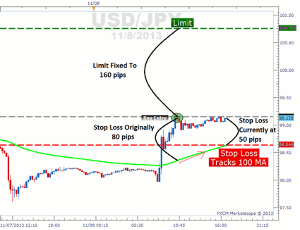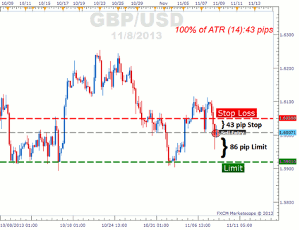Having an exit plan is just as important as having a rationale for entering a trade to begin with, writes Rob Pasche of DailyFX.com, and here he shares three simple ways for determining your exit.
Through emails, phone calls, and tweets many traders I work with on a daily basis are quick to point out why they are entering a trade and are able to describe each setup in great detail. But something I see much less of are traders talking about their exit plans.
Most prudent traders will set up a stop and a limit to go along with their trade, but I’d venture to guess most traders are spending a lion’s share of their time on worrying about getting good entries. This would mean they set up their exit strategy as an afterthought, which as a trading instructor, concerns me.
Our exits should be just as well thought out as our entries and we need to have clear reasons on where we exit our trades and under what conditions. Without an exit strategy, we are taking on a lot more risk than we should be.
Below are three basic (yet effective) ways to exit your positions.
Exit Strategy #1 – Traditional Stop/Limit (Using Support & Resistance)
The traditional stop/limit method is one that I use constantly during my simple trading strategy webinars. I like it because it is both versatile and effective. The goal is setting our stop and limit so that they have a positive risk to reward ratio and are set around support and resistance levels. Let's take a look at an example of a short euro trade against the USD that occurred a couple weeks back on a daily RSI chart.
Traditional Stop/Limit Based on Support & Resistance

(Created from Marketscope 2.0)
Click
to Enlarge
When selling a pair, we want to look back at the previous bars and look for an obvious swing high. That swing high could potentially act as a resistance level in the future, so we would like to set our stop loss several pips above that level. This way, the only way we are taken out of the trade is if the pair has enough strength to make a new high. This is fine because if a pair is showing that much strength, it's not a pair that we want to be selling anymore anyway.
Next, the limit order we place will be 100% dependent on our stop loss’ distance. Using the ruler tool on our chart, we should figure out how far our stop loss is set in pips. In this example, our stop is 100 pips from our entry price. We should set our limit twice as far as our stop. That is 200 pips in this example. This is will give us a 1:2 risk to reward ratio.
The next exit strategy is an interesting one for many, because it includes trading automation.
Exit Strategy #2 – Moving Average Trailing Stop
It has long been known that a moving average can be an effective tool to filter what direction a currency pair has trended. The basic idea is that we only look for buying opportunities when the price is above a moving average and we only look for selling opportunities when the price is below a moving average. But some traders have found that it can be effective to use a moving average as a stop loss.
NEXT PAGE: Volatility-Based Stop & Limit
|pagebreak|The idea is that if a MA is crossed from one side to the other, then the trend is shifting. If we were trend traders, we would want to close out our positions once this shift has occurred. So this is why setting your stop loss based on a moving average could be effective.
In the example below, we are looking at a M15 chart of the USD/JPY, which is currently in an uptrend based on the 100-period exponential moving average. At the time when I opened this long position, I placed our stop loss directly at the 100 EMA level. This put our stop loss about 80 pips away. Wanting to stay true to our 1:2 risk to reward ratio rule, I set my limit at 160 pips.
Stop Loss Based on 100-Period Moving Average

(Created from Marketscope 2.0)
Click
to Enlarge
As the trade develops, the exponential moving average is going to change with each new candle that is created every 15 minutes. As the EMA moves, we will update our stop loss to match the 100 EMA. You can see that from the time I opened the trade until now, the 100 EMA has risen 30 pips, raising our stop loss 30 pips alongside it. This means almost 40% of the risk we were taking on our trade originally is now gone. But you will notice, our limit stays fixed at the amount of pips it was originally set to. This means our risk to reward ratio improves throughout the life of the trade.
Obviously I know many of the forex traders reading this do not have the time to manually change their stop loss every time their chart prints a new candle, so I am including free download links to automated strategies that will automatically adjust your stop loss in real time to match the MA of your choosing. As long as your platform remains open and connected to FXCM’s trade servers, your stop will continue to move until the trade is closed.
Download – Moving Average Automated Stop Loss (Non-FIFO, Non-US Based)
Download – Moving Average Automated Stop Loss (FIFO, US Based)
Exit Strategy #3 – Volatility-Based Stop & Limit
I’ve saved the easiest exit strategy for last. This final technique uses the ATR (average true range). The ATR is designed to measure market volatility. By taking the average range between high-low prices for the last 14 candles, it tells you how erratic the market is behaving and this can be used to set your stop and your limit for each trade.
The greater the ATR is on a given pair, the wider your stop should be. This makes sense because a tight stop on a volatile pair could get stopped out too early. Also, if we set our stop too wide for a slow moving pair, we might be taking on a larger risk than we really ought to.
I recommend setting your stop loss at least 100% of ATR. In the example below, we set our stop loss at 43 pips. Following our 1:2 risk to reward ratio, we set our limit twice as far, 86 pips.
Stop Loss & Limit Based on Volatility (ATR)

(Created from Marketscope 2.0)
Click
to Enlarge
Ending With a Bang
Remember that forex trading is more than just getting good entries; your exits should be just as important. You should always have a game plan before you open any position and I hope the three exit strategies in this article will help you develop a winning system or help improve upon an existing system.
By Rob Pasche, Trading Instructor, DailyFX.com


















